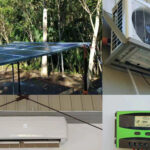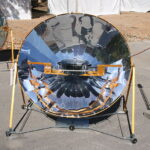The trucking industry is one of the largest contributors to greenhouse gas emissions, with semi-trucks being a significant portion of that output. As concerns about climate change continue to grow, the need for sustainable solutions in the transportation sector has become increasingly urgent. One promising innovation that has gained traction in recent years is the use of solar panels on semi-trucks. In this blog post, we’ll explore the benefits, costs, installation process, and drawbacks of solar panels for semi-trucks.
Benefits of Solar Panels for Semi Trucks
A wide range of benefits of solar panels on semi trucks are mentioned below:
Reduced Emissions
The most significant advantage of solar panels for semi-trucks is their ability to reduce greenhouse gas emissions. By harnessing renewable energy from the sun, these panels can significantly decrease the amount of carbon dioxide emitted by diesel engines. According to the Environmental Protection Agency (EPA), medium-duty and heavy-duty vehicles account for approximately 23% of greenhouse gas emissions from the transportation sector. Solar panels can help mitigate this impact by reducing reliance on fossil fuels.
Fuel Savings
Another benefit of solar panels for semi-trucks is fuel savings. With the ability to generate electricity from the sun, solar panels can power various systems within the truck, such as lights, air conditioning, and refrigeration units. This reduces the load on the engine, resulting in lower fuel consumption and costs. Studies suggest that solar panels can save up to $5,000 per year on fuel costs for a single semi-truck.
Lower Maintenance Costs
Solar panels require minimal maintenance compared to traditional diesel engines. They have fewer moving parts, which means there’s less wear and tear, and they don’t require oil changes or tune-ups. This reduction in maintenance needs can lead to significant cost savings over time.
Increased Lifespan
Solar panels are designed to last longer than traditional combustion engines. While diesel engines typically have a lifespan of around 150,000 miles, solar panels can last upwards of 250,000 miles or more. This increased lifespan means reduced replacement costs and extended usage.
Improved Performance
Solar panels can also improve the performance of semi-trucks. By providing additional power for accessories like air conditioning and heating, drivers can maintain a comfortable cabin temperature without worrying about idling. Additionally, solar panels can provide backup power during unexpected downtime, ensuring that critical systems remain operational.
Cost of Installing Solar Panels for Semi Trucks
While the benefits of solar panels for semi-trucks are numerous, the initial investment may seem daunting. However, it’s important to consider the long-term savings and environmental benefits when evaluating the cost. Here are some estimates for installing solar panels on semi-trucks:
- System Size: The size of the solar panel system required will depend on several factors, including the size of the truck, driving habits, and the amount of energy needed to power accessories. Typically, a semi-truck requires a minimum of 800 watts of solar power to make a significant impact on fuel consumption.
- Installation Costs: The cost of installation varies depending on the complexity of the installation, location, and type of equipment used. On average, the total installed cost of a solar panel system for a semi-truck ranges between $15,000 and $25,000.
- Payback Period: Despite the initial investment, the payback period for solar panels on semi-trucks can be relatively short. With fuel savings alone, the system can pay for itself within three to five years. When factoring in other benefits like reduced maintenance and extended lifespan, the return on investment can be even shorter.
Installation Process for Solar Panels for Semi Trucks
Installing Solar Panels on Semi-trucks Involves Several Steps. Here’s an overview of what you can expect:
Site Assessment
Before installation, a site assessment is conducted to determine the best location for the solar panels. Factors considered include sun exposure, shading, and roof space.
System Design
Once the site assessment is complete, a system design is created that takes into account the truck’s electrical requirements, route, and duty cycle. The design includes selecting the appropriate solar panel modules, charge controllers, batteries, and other components.
Component Selection
High-quality components that can withstand harsh environments and extreme temperatures are essential for semi-truck solar panel installations. Components should be selected based on durability, efficiency, and compatibility with the existing electrical system.
Roof Preparation
The roof of the semi-truck must be prepared to ensure a secure mounting surface for the solar panels. This may involve cleaning the roof, applying a protective coating, and attaching a mounting rack.
Panel Installation
The solar panels are then attached to the mounting rack using durable clamps or brackets. Care should be taken to ensure proper alignment and angle for optimal energy production.
Wiring and Connectivity
The solar panels are connected to the truck’s electrical system via wiring and connectors. This requires careful planning and execution to ensure safe and efficient energy transfer.
Testing and Commissioning
Once the installation is complete, the system is tested to ensure it’s functioning properly. This includes checking voltage, current, and charging rates, as well as testing the system’s safety features.
Ongoing Maintenance
Finally, regular maintenance is crucial to ensure the longevity and efficiency of the solar panel system. This includes cleaning the panels, inspecting connections, and monitoring system performance.
Drawbacks of Solar Panels for Semi Trucks
While solar panels offer many advantages for semi-trucks, there are also some potential drawbacks to consider:
- Weight: Solar panels add weight to the vehicle, which can affect its overall fuel efficiency and handling. This may require adjustments to the truck’s suspension or weight distribution.
- Aerodynamics: Solar panels can create drag, which can negatively impact the truck’s aerodynamics and fuel efficiency at high speeds. Careful placement and angling of the panels can minimize this effect.
- Charging Time: Solar panels rely on sunlight to generate electricity, so charging times can vary depending on weather conditions and seasonality. Drivers may need to park their trucks for extended periods to allow the batteries to fully charge.
- Battery Life: Deep-cycle solar batteries used in solar panel systems have a limited lifespan due to the constant cycling involved in charging and discharging. Battery life can range from 3-5 years, depending on usage patterns and the quality of the batteries.
- Upfront Costs: While the long-term benefits of solar panels can outweigh the costs, the initial investment for a high-quality system can still be prohibitively expensive for some fleet owners or independent operators.
Conclusion
Solar panels offer a compelling solution for semi-trucks, providing a cleaner, quieter, and more efficient way to power the electrical systems of these vehicles. While there are some drawbacks to consider, advances in technology and declining costs have made solar panels an increasingly viable option for fleets and owner-operators alike. Proper installation, maintenance, and driver education are key to maximizing the benefits of solar panels and minimizing any challenges associated with their adoption. As the transportation industry continues to evolve toward greater sustainability, solar panels are likely to play an expanding role in the transition toward alternative energies.

















